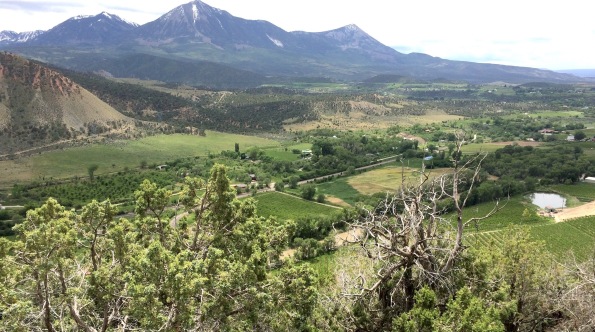Archive
Is it sustainable? Focusing on a living wine and a healthier world

The fields, orchards and vineyards of the North Fork Valley provide a living laboratory for a hot-bed of awareness in low-impact agriculture. Cutting-edge techniques combined with methods gleaned from ancient cultures may provide insights to protecting a fragile environment. Story and photos by Dave Buchanan.
Even while our society is awash in products ranging from clothing to fine dining labeled as natural or organic, confusion abounds for consumers and often producers.
Partly it’s because the rules or guidelines that define what those terms actually mean confound most parties.
It’s also partly because consumers interested in “being green” can’t always find products that fit their expectations.
According to a 2009 study by the Grocery Manufacturers Association and the research firm DeLoitte, 54 percent of the more than 6,400 shoppers polled showed a preference for environmentally friendly products but only 22 percent actually bought green.
Several reasons were outlined in the study, major among them “communication and product education,” said the report.
“We found … it’s not enough to just put green products on the shelf,” said Brian Lynch, GMA director of sales and sales promotion. “We have to better educate consumers and leverage in-store communication to make the sale.”
It’s not so different in the world of winemaking. Wines can carry such varied labels as “low sulfite,” “natural,” “organic” or even “made with organic grapes,” all of which mean something different, and often nothing, to the consumer.
Broadly speaking, you can lump all winemaking under one of two processes: conventional and sustainable.
Conventional is how the great majority of winemakers pursue their art. Pesticides, herbicides and fungicides in the vineyard; preservatives, color enhancers and custom yeasts to provide desired flavors may be added in the winery.
“Sustainable” winemaking is the umbrella under which you’ll find natural, organic and biodynamic methods of winemaking. The rules get progressively more restrictive as you moved from natural to biodynamic.
According to the website RawWine.com, natural wine is farmed organically or biodynamically, following the strict procedures delineated by Rudolf Steiner, with minimal intervention in the vineyard and the winery.
“The result is a living wine – wholesome and full of naturally occurring microbiology,” said the website.

Author and sustainability expert Sandra Taylor (right, in red) discusses her latest book, “The Business of Sustainable Wine” during VinExpo 2018 with Molly Clemens, a Ph.D student of Ecology at San Diego State University. Taylor’s book explains how sustainable agriculture may be our only cogent response to human-caused climate change.
Author Isabelle Legeron, MW, in her book “Natural Wine,” says a natural wine is one that can survive without a “technological crutch.”
“In its truest form,” writes Legeron, “it is wine that protects the microcosm of life in the bottle in its entirety, keeping it intact so that it remains stable and balanced.”
Sustainability includes using no additives or processing aids, including yeasts, in the fermentation process.
In her new book “The Business of Sustainable Wine,” Sandra Taylor says wine, unlike most other agricultural products, allows both producer and consumer to focus “on the wine grape’s place of origin and the details of the wine’s making.”
Taylor is a former executive for Starbucks Coffee, where she helped develop guidelines for Starbucks’ innovative work in sustainability for coffee, tea and cocoa.
I spoke with Taylor during Vinexpo 2018 in early March at the Javits Center in New York and during our conversation, she noted that despite a growing interest and awareness in a wine’s origin, the wine industry is lagging behind in sustainable agriculture, both in environmental terms and in meeting consumers’ growing demands.
In her book, she also draws a line between “sustainable” agriculture (including economic, social and environmental sustainability) and organic and biodynamic practices.
While Rachel Carson’s landmark 1962 book “Silent Spring” is universally heralded as ushering in the age of environmentalism, it wasn’t until the 1980s that Americans “began to seriously consider” where their food comes from or “what food production does to the planet, their bodies and their society,” Taylor writes. Her book is available through Grand Valley Books, 350 Main Street, in Grand Junction and other book sellers.
Other writers, including poet and environmentalist Wendell Berry, Frances Moore Lappé (“Diet for a Small Planet”) and ecologist Barry Commoner, further introduced Americans to the impacts of industrial farming and the benefits of sustainable farming.
Over the next few weeks, I’ll be talking to many winemakers who produce sustainable wines, including a group of more than 100 Italian winemakers at Vini Veri, the annual fair and exposition in Cerea, Italy, a small town in northern Italy a few kilometers south of Verona.
Those producers adhere to a dictum that avoids pigeonholing wineries as “bio” or “non-bio” but rather emphasizing, as the Vini Veri website states, “the best balance between human intervention and nature in the winemaking process.”
Next time, we’ll talk more about sustainability in winemaking and look at how it is practiced in Colorado winemaking. (Spoiler alert: Not so much.)
In a land of fire and smoke, fine wines are born

The lava flows of Mt. Etna are the background for the rich microclimates in Sicily’s vineyards. Photo courtesy Hotel La Perla
Fire and lava normally aren’t considered attributes for producing elegant wines.
But for Chiara Vigo, who makes unadorned natural wines on her family’s estate, Fattorie Romeo del Castello, in the shadow of Sicily’s Mt. Etna, having an active volcano in her backyard is a way of life.
“For us, it’s a part of our life, something we see every day,” said Chiara during a brief conversation last spring at Vini Veri, a three-day gathering of natural wine makers in Cerea, Italy.
In 1981, when Chiara still was a young girl, well before she went off to earn a Ph.D in art and before she became a wine maker, Etna erupted, spewing ash and smoke and sending rivers of lava down its side.
One lava flow, which Chiara described as tall as a house, approached the estate, which grew grapes, olives and hazelnuts on roughly 60 hectares (about 145 acres) on Etna’s north side.

Chiara Vigo and Gianluca Torrisi show the 2013 Vigo during Vini Veri this spring in Cerea, Italy. Photo by Dave Buchanan
“We thought we would have to leave and lose everything, but when the lava arrived at the part of the old vineyard, it changed direction,” recalled Chiara in a story she’s told countless times.
Instead of engulfing the vineyard, the river of molten rock turned to the east, toward the Alcantra River.
“So now we have a vineyard with a big flow of lava rock inside the vineyard,” she said.
The 1981 eruption wasn’t Etna’s largest or even its most-recent but it does emphasize a certain aspect of danger not usually associated with winemaking, where the prevalent major threats are pests, bad weather and changing markets.
“You see the signs (of the volcano) everywhere,” said Vigo. “But it’s the lava rocks that give us such rich soil and make our wines special.”
That 1981 eruption left her family with 24 hectares (about 57 acres) of Nerello Mascalese vines, some just now starting to produce but also about 14 hectors of 70-100-year old vines in vineyards that reach close to 4,000 feet elevation. Here, under the Romeo del Castello label, she creates what might be called super-organic wines, going beyond the European organic certification and just short of biodynamic: without pesticides or added chemicals and using natural yeasts.
“We try to use the methods of the past traditions of Etna,” she said in the hubbub of La Fabbrica, the vast building in which Vini Veri 2017 was held. “We plant beans in the vineyards to feed the vines.”
This nonintrusive way of adding nitrogen and building the soil now is used by many producers of natural and organic wines.
“And it means instead of using herbicides, we cut the grass” between the rows, she said.
Grapes are hand-harvested and fermented using natural yeasts in open wooden vats.
The wines are aged in oak casks for about 14 months before being bottled without fining or filtration.
“We use only a little sulphur and only when we bottle,” she explained.
She makes two wines, both DOC Etna Rosso: the Vigo made only during the best vintages and the Allegracore, fermented in stainless steel instead of oak.

The 1981 eruption of Mt. Etna left this wall of lave bordering the vineyards of Fattorie Romeo del Castello. Photo – Louie Dressner Selections.
Sicily has more than 2,500 years of winemaking history (Nerello Mascalese has been grown on the Etna slopes for at least 200 years) but production was decimated when phylloxera arrived in the 1930s. While the island once had a reputation as a major producer of bulk wines, over the last 20 years its winemaking has become as complex as anywhere in the world.
Extended harvests (starting in August in the south to extending to mid-November on Etna’s slopes), rich soils and the new fervor of enlightened producers bring an exciting air to this island’s wine futures. In his book “Brunello to Zibibbo,” author Nicholas Belfrage, a British Master of Wine, argued that Sicily has the potential to be “California, Australia, Chile, southern France, Jerez and middle Italy all rolled into one.”
But as someone who lives everyday with the threat of an active volcano looming over her shoulder, Chiara Vigo shrugged at that proclamation.
“It’s true the wines of Etna have changed a great deal in the last 10 or 15 years,” she said. “I make our wines to reconnect with our ancestors and I can’t imagine doing it any way else.”
She pause while opening her 2013 Vigo. “It’s just another way to think, and to see agriculture and to see the earth. It’s our future.”
Her wines are imported by Louie Dressner Selections.